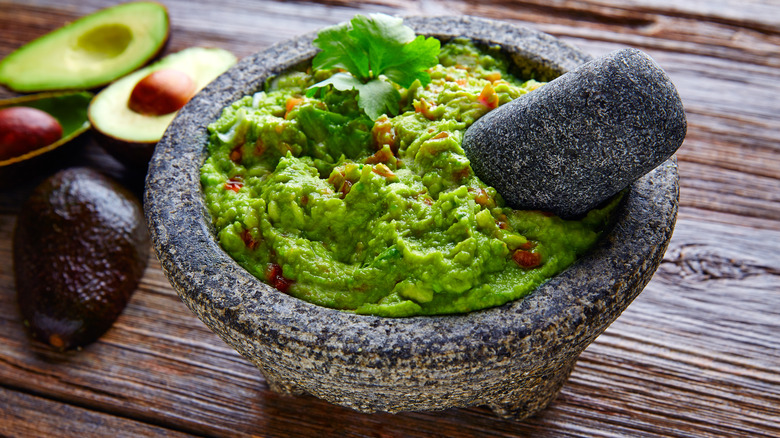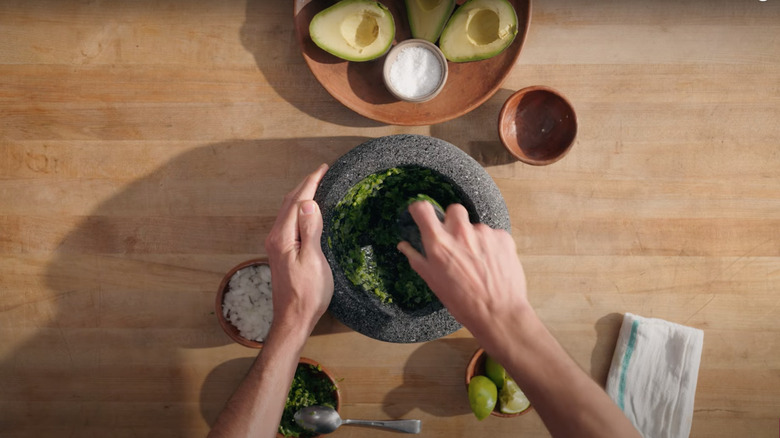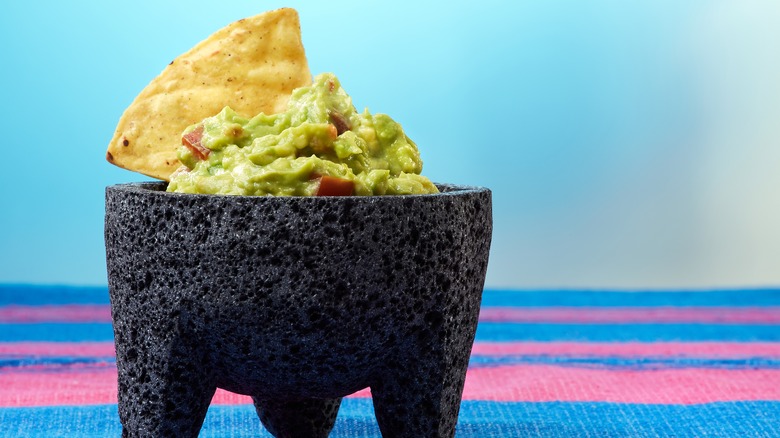There's A Wrong Way To Use A Mortar And Pestle For Making Guacamole
A traditional Mexican version of a mortar and pestle — called a molcajete — is a natural choice for making guacamole. It requires more elbow grease than using a blender, but crushing the herbs and aromatics in your recipe releases more of their essential oils. You get guacamole that is bursting with flavor, has evenly-distributed ingredients, and a consistency that is creamy yet chunky, for more textural intrigue. However, you can't just add everything to the bowl and bash it to death, or you'll end up with a watery mess.
Rather than adding all your ingredients to the mortar and indiscriminately mashing them up, start with your chopped onions, herbs like cilantro, chilies such as jalapeños or serranos, and citrus juice. Grind all of these ingredients into a fine paste. Then, add cubed avocado and salt, and mix and mash with the pestle more gently to combine. You want the avocado to be broken-down, but not totally smooth. Gently stir in diced tomatoes at the very end. If you add them any earlier, they'll bruise and release tons of water, making your dip thin with a weaker flavor.
Creating an aromatic base of herbal, spicy, and zingy ingredients allows for a more vibrant taste, and an even distribution of that flavor — no more blowing out your palate by biting into a chunk of onion or piece of hot pepper. This method upgrades even the best basic guacamole recipe, with a texture and flavor that's far more dynamic.
The benefits of a molcajete, and how to use it
A molcajete, a three-footed bowl, is used with a wide, rounded pestle called a tejolote. Both tools are traditionally made using volcanic rock, and can be traced back to indigenous peoples in present-day Central America. The origin of guacamole is just as ancient, so using a molcajete just might be the best path to an authentic guacamole experience.
The shallow bowl and textured stone of a molcajete is ideal for grinding both fresh and dried ingredients into a paste. Volcanic rock is also porous — even once it has been properly cured — so it will absorb the flavors of food over time. This seasoning perfumes everything you make in a molcajete. To help a molcajete work with less physical effort on your part, cut your ingredients into smaller pieces and use a pushing and twisting motion (instead of an up-and-down bashing movement) with the tejolote. Press the gucamole down the sides of the bowl to allow the rough texture to break up the ingredients.
A regular mortar and pestle with a smooth finish and narrow bowl is better suited for pulverizing spices and seeds, but a molcajete is better suited for dips. If you prefer to use a smaller mortar and pestle that you already own, consider making the aromatic paste, then combining it with the avocado in a mixing bowl, so the fruit isn't pulverized to a totally smooth texture.
More guacamole tips
For the best guacamole, you want an avocado that is soft enough to be mashed, but firm enough to not turn into a watery pulp. The Hass variety is a great choice, and you can use the hidden color code to tell an avocado's ripeness by plucking out the stem cap. Underneath the stem, the flesh should be yellowish-green.
Quality really matters for the rest of the ingredients. This is a simple dish where the vegetables really shine, so you will want fresh, firm onions; green, crisp cilantro; snappy chilies; and freshly-squeezed lime juice. You might want to start out with lesser quantities than you normally would, since crushing these ingredients with a mortar and pestle intensifies their flavors. If you don't have a mortar and pestle, give the veggies a quick blitz in the blender or food processor to make a rough, chunky paste. As for the tomatoes, slice them in half and remove some of the seeds and pulp to avoid introducing too much liquid.
Here's another great tip: Chill your molcajete. A cold bowl keeps all the ingredients bright and fresh as you mash them, and you can serve the dip straight from the molcajete, as is traditional in Mexico. Top with an extra sprig of cilantro or a sprinkle of salty cotija cheese, and serve with plenty of corn tortilla chips.



